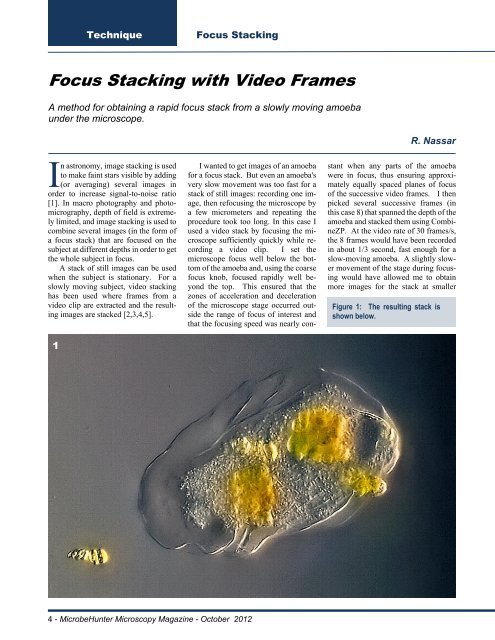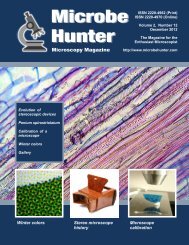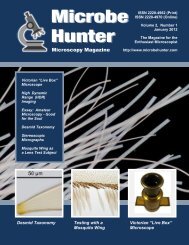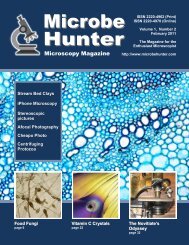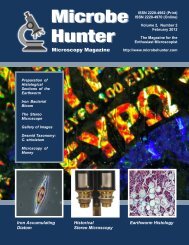October 2012 - MicrobeHunter.com
October 2012 - MicrobeHunter.com
October 2012 - MicrobeHunter.com
You also want an ePaper? Increase the reach of your titles
YUMPU automatically turns print PDFs into web optimized ePapers that Google loves.
Technique<br />
Focus Stacking<br />
A method for obtaining a rapid focus stack from a slowly moving amoeba<br />
under the microscope.<br />
R. Nassar<br />
In astronomy, image stacking is used<br />
to make faint stars visible by adding<br />
(or averaging) several images in<br />
order to increase signal-to-noise ratio<br />
[1]. In macro photography and photomicrography,<br />
depth of field is extremely<br />
limited, and image stacking is used to<br />
<strong>com</strong>bine several images (in the form of<br />
a focus stack) that are focused on the<br />
subject at different depths in order to get<br />
the whole subject in focus.<br />
A stack of still images can be used<br />
when the subject is stationary. For a<br />
slowly moving subject, video stacking<br />
has been used where frames from a<br />
video clip are extracted and the resulting<br />
images are stacked [2,3,4,5].<br />
1<br />
I wanted to get images of an amoeba<br />
for a focus stack. But even an amoeba's<br />
very slow movement was too fast for a<br />
stack of still images: recording one image,<br />
then refocusing the microscope by<br />
a few micrometers and repeating the<br />
procedure took too long. In this case I<br />
used a video stack by focusing the microscope<br />
sufficiently quickly while recording<br />
a video clip. I set the<br />
microscope focus well below the bottom<br />
of the amoeba and, using the coarse<br />
focus knob, focused rapidly well beyond<br />
the top. This ensured that the<br />
zones of acceleration and deceleration<br />
of the microscope stage occurred outside<br />
the range of focus of interest and<br />
that the focusing speed was nearly constant<br />
when any parts of the amoeba<br />
were in focus, thus ensuring approximately<br />
equally spaced planes of focus<br />
of the successive video frames. I then<br />
picked several successive frames (in<br />
this case 8) that spanned the depth of the<br />
amoeba and stacked them using CombineZP.<br />
At the video rate of 30 frames/s,<br />
the 8 frames would have been recorded<br />
in about 1/3 second, fast enough for a<br />
slow-moving amoeba. A slightly slower<br />
movement of the stage during focusing<br />
would have allowed me to obtain<br />
more images for the stack at smaller<br />
Figure 1: The resulting stack is<br />
shown below.<br />
4 - <strong>MicrobeHunter</strong> Microscopy Magazine - <strong>October</strong> <strong>2012</strong>


